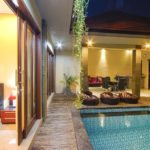Tips & FAQs
Helpful Hints from Chlorine Myths to Eye Irritation Solutions
CHLORINE… ITS PURPOSE AND APPLICATION
 Disinfection is the most important single factor in maintaining a swimming pool, which is safe and healthy. Chlorine is the most widely applied disinfecting agent and used by Clean And Clear Pools for the disinfection of your residential swimming pool water.
Disinfection is the most important single factor in maintaining a swimming pool, which is safe and healthy. Chlorine is the most widely applied disinfecting agent and used by Clean And Clear Pools for the disinfection of your residential swimming pool water.CONDITIONER
 Conditioner (or stabilizer) is an essential chemical used in the proper disinfection of swimming pools. Its chemical name is cyanuric acid and it forms a protective bond around the chlorine, making it more resistant to being burned off by the sun. This chemical is typically added during the spring months, but pools with high water loss will also need to be reconditioned throughout the summer. This is a very expensive chemical and we ask that you DO NOT backwash or clean your filter for five days after this chemical has been added. Pools should also be stabilized whenever large amounts of fresh water are added. It will sometimes appear as a white powdered substance on the bottom of the swimming pool, but will dissipate after a few days (brushing helps).
Conditioner (or stabilizer) is an essential chemical used in the proper disinfection of swimming pools. Its chemical name is cyanuric acid and it forms a protective bond around the chlorine, making it more resistant to being burned off by the sun. This chemical is typically added during the spring months, but pools with high water loss will also need to be reconditioned throughout the summer. This is a very expensive chemical and we ask that you DO NOT backwash or clean your filter for five days after this chemical has been added. Pools should also be stabilized whenever large amounts of fresh water are added. It will sometimes appear as a white powdered substance on the bottom of the swimming pool, but will dissipate after a few days (brushing helps).Algae… It’s types and appearance
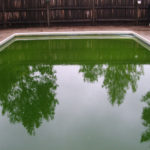 Algae are very tiny plants that grow in untreated water. The air contains millions of algae spores that either settles into the water or is carried in during rainstorms or by fill water. Once present in water they may be recognized initially, by the formation of slime on the sides and floor of the pool developing into a general cloudiness in the body of the water. In the advanced stages of growth, they take on a green color and, if allowed to progress further, will take on a brownish color. Intense sunlight is very conducive to algae growth by causing increased water temperatures and more rapid loss of residual chlorine. The following three forms of algae are most commonly found throughout the Southwest Region:
Algae are very tiny plants that grow in untreated water. The air contains millions of algae spores that either settles into the water or is carried in during rainstorms or by fill water. Once present in water they may be recognized initially, by the formation of slime on the sides and floor of the pool developing into a general cloudiness in the body of the water. In the advanced stages of growth, they take on a green color and, if allowed to progress further, will take on a brownish color. Intense sunlight is very conducive to algae growth by causing increased water temperatures and more rapid loss of residual chlorine. The following three forms of algae are most commonly found throughout the Southwest Region:
- Green Algae
Green algae is the most common form of algae. It appears as a streaky, slimy buildup, first noticeable on steps, in corners, and on the plastic surfaces of skimmers and return fittings. - Yellow or Mustard Algae
Yellow algae, also known as mustard algae, usually starts on the shady side of the swimming pool. Yellow algae has the same slimy texture as green algae, but it is more difficult to remove. Yellow algae thrives in shade, and will often appear in covered pools. This form of algae grows in a long, streaky pattern, appearing on pool walls, in corners, and on steps and love seats. - Black Algae
Black algae is the least common form of algae, but once it blooms it is the most stubborn and is the most difficult of the three to eradicate. Black algae is a water borne spore, and is carried into your pool through the fresh water used to fill your swimming pool. Black algae is usually the result of insufficient chlorine levels for an extended period of time. Black algae is most often found in leaky swimming pools that require near-daily replenishment of pool water. As large amounts of water are added to the pool, chlorine and stabilizer levels drop, promoting an inviting environment for black algae to form its roots.Should algae be allowed to gain a foothold in the pool, “shock” treatment is often necessary to remove the growth.
It is commonly known that black algae is so stubborn and resistant and in many cases deeply embedded into the plaster and can only be controlled and not completely eliminated. An Acid Wash and Chlorine bath does not always work; sometimes replastering the surface is required to completely eliminate black algae. In almost all cases, Clean And Clear Pools water treatment system can control and many times eliminate black algae from your pool. (If anyone can do it our professional chemical service can)Because some strains of algae are more resistant than others, please allow us a reasonable period to completely eradicate it. The more resistant black algae will turn gray as it starts to die and will eventually disappear. Your keeping the pool clean and brushing with your algae brush will aid in the treatment of the algae.
Filtration
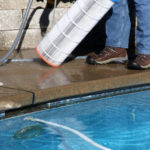 Filtration of your pool is extremely important. To be assured that all of your pool water has been filtered, the total gallons of the pool must be pumped through the filter three times. One long continuous run of your filtration system of 24 hours or more is far more effective than short filtration cycles. Your filter should be cleaned when the pressure gauge on top of the filter indicates ten to twelve pounds increase in pressure above the normal clean pressure level. The average
Filtration of your pool is extremely important. To be assured that all of your pool water has been filtered, the total gallons of the pool must be pumped through the filter three times. One long continuous run of your filtration system of 24 hours or more is far more effective than short filtration cycles. Your filter should be cleaned when the pressure gauge on top of the filter indicates ten to twelve pounds increase in pressure above the normal clean pressure level. The averagefiltration time required is 10 to 12 hours daily in the summer, times change with seasons.
PLEASE NOTE: THOSE WHO ENCOURAGE REDUCTION IN POOL FILTRATION HAVE A MOTIVATION THAT IS NOT IN YOUR BEST INTEREST! PROPER FILTRATION IS EXTREMELY IMPORTANT FOR PROPER POOL CARE!
Filter Test
If you are still experiencing cloudy water after following the above recommendations, run this simple filter test; turn your filter on and let it run for 24 to 48 continuous hours. If you do not see a marked improvement in the clarity of your water within 24 hours or the water is not completely clear in 48 hours, your filter is not holding back the material that is making the water cloudy. Repair or replacement of the filtering element is needed.
Cleaning Cartridge Filters
1. Turn off the pump
2. Remove cartridge elements from canister and clean with water hose (do not power wash)
3. Replace clean elements into canister
4. Turn on the pump and open the air relief on the top of the filter to bleed all air from the system
Have cartridge elements checked every year for wear and tear.
There may be as few as one or as many as fifteen or more cartridge elements inside a cartridge filter. The cartridge elements are cylindrical, and made of a paper-like fiber. As the water passes through the elements, small tiny particles are collected on the element material. Cartridges remove smaller debris from the water than sand; its micron rating is about 20 microns. This filter should be is cleaned every 3 to 4 months by removing the elements from the canister and hosing it off using a high-pressure nozzle.
Drawbacks for the cartridge filter include:
Most cartridge filters are for smaller pools and spas containing approximately 12,000 gallons of water or less. There is no mechanical method for backwashing these filters – it must be manually disassembled and hosed off. The cartridge elements need to be replaced as they become old and worn: about every 3-5 years, which can be expensive, depending on the size, style and brand of cartridge.
Green Algae
Green algae is the most common form of algae. It appears as a streaky, slimy buildup, first noticeable on steps, in corners, and on the plastic surfaces of skimmers and return fittings.
- Yellow or Mustard Algae
Yellow algae, also known as mustard algae, usually starts on the shady side of the swimming pool. Yellow algae has the same slimy texture as green algae, but it is more difficult to remove. Yellow algae thrives in shade, and will often appear in covered pools. This form of algae grows in a long, streaky pattern, appearing on pool walls, in corners, and on steps and love seats. - Black Algae
Black algae is the least common form of algae, but once it blooms it is the most stubborn and is the most difficult of the three to eradicate. Black algae is a water borne spore, and is carried into your pool through the fresh water used to fill your swimming pool. Black algae is usually the result of insufficient chlorine levels for an extended period of time. Black algae is most often found in leaky swimming pools that require near-daily replenishment of pool water. As large amounts of water are added to the pool, chlorine and stabilizer levels drop, promoting an inviting environment for black algae to form its roots.Should algae be allowed to gain a foothold in the pool, “shock” treatment is often necessary to remove the growth.
It is commonly known that black algae is so stubborn and resistant and in many cases deeply embedded into the plaster and can only be controlled and not completely eliminated. An Acid Wash and Chlorine bath does not always work; sometimes replastering the surface is required to completely eliminate black algae. In almost all cases, Clean And Clear Pools water treatment system can control and many times eliminate black algae from your pool. (If anyone can do it our professional chemical service can)Because some strains of algae are more resistant than others, please allow us a reasonable period to completely eradicate it. The more resistant black algae will turn gray as it starts to die and will eventually disappear. Your keeping the pool clean and brushing with your algae brush will aid in the treatment of the algae.
SOLUTION TO EYE IRRITATION
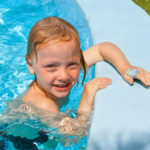
1. Keep your pool clean.
2. Clean your filter as instructed under paragraph on filtration.
3. Take necessary steps to keep urine out of your pool (SIGNS HELP!)
4. Swimmers who have been perspiring should shower before swimming.
5. Follow our recommended hours of filtration.
6. Keep filter in good repair.
7. Follow our instructions for use of pool covers.
8. Water should be added AFTER you swim, NEVER BEFORE you swim!High chlorine levels in your pool are an ADVANTAGE to you, and do not create eye irritation. Some people associate the smell of chlorine (which isn’t actually chlorine, but rather “chloramines” that give off the odor) and eye irritation with too much chlorine in the water. Generally the opposite is true and super chlorination is a requirement.
Algae… What Causes It?
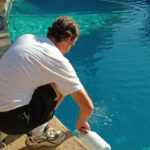 Clean And Clear Pools water treatment system guarantees a crystal clear, algae free swimming pool. However, even when chemical levels are properly balanced, algae will occasionally appear in a customer’s swimming pool. Algae comes in a variety of forms, and appears for various reasons.
Clean And Clear Pools water treatment system guarantees a crystal clear, algae free swimming pool. However, even when chemical levels are properly balanced, algae will occasionally appear in a customer’s swimming pool. Algae comes in a variety of forms, and appears for various reasons.
Algae spores are everywhere: these microscopic single-cell structures are blown into the pool by the wind, washed into the pool by rainfall, or carried into the pool on swimmers’ skin or bathing suits. Under the right conditions, tiny spores will bloom into those dreaded bright green, mustard yellow, or black discolorations.
Here are the key factors in algae growth:
Inadequate filtration will often lead to algae growth. Water clarity depends on daily circulation and filtration. Anything that impedes water flow from the pool to the filter — clogged skimmer baskets, a dirty or damaged filter, a defective pump motor, or a failure to run the pump for an adequate amount of time each day — will encourage algae growth. The first warning sign of a filtration problem is hazy or cloudy water. Left unchecked, cloudy water can quickly lead to a full-fledged algae bloom.
Algae can develop when little or no chlorine is present. Sunlight, rainfall, temperature, number of swimmers and frequency of pool use affect the rate of chlorine loss. The lower the chlorine level, the more likely algae will bloom. Super-chlorination, coupled with the application of conditioner or stabilizer designed to shield residual chlorine from the effects of heat and sunlight, helps ensure that there is always sufficient chlorine in the pool. Spas, which are often heated to temperatures well above 100 degrees, are especially susceptible to algae growth.
Algae loves a dirty pool! Leaves and dirt left on the bottom of the pool for an extended period of time, not only promotes algae but also causes pool staining. The longer you allow leaves and other debris to sit on your pool floor, the more likely that you’ll see algae, and staining. In an extremely dirty pool, algae will continue to bloom, even when the water chemistry is properly balanced.
What can you do to prevent algae?
- Immediately after using the spa, adjust the valves so that the pool water will flow through the spa when the filtration system is running. This will replenish chlorine-dissipated spa water with chlorinated water from the main part of the swimming pool.
- Remove your pool cover one day per week to allow the water to “breathe”. For best results, uncover the swimming pool on your regular scheduled service day.
- Periodically check to make sure the water is circulating adequately. Clean or backwash your filter if necessary.
- Make sure the pump timer is set to run for at least 4 to 5 hours each day in the winter, and 10 or more hours daily during the summer months.
- Contact Clean And Clear Pools customer service department — we’ll dispatch a service technician to double check chemical levels and, if necessary, re-treat the pool!
- Make sure your filter is clean and your return lines have strong water flow.
- Some spots of dead algae may remain on your pool walls, even after chemical treatment. Brushing the pool walls with a nylon bristle pool brush will remove dead algae, and help keep live algae from forming. A stainless steel brush should be used when dealing with black algae; it is made for this purpose and works great!!
SOLAR SYSTEMS
CLOUDY WATER
POOL COVERS
AUTOMATIC POOL SWEEPS
SPAS AND HOT TUBS
SPARKLING SANITARY SWIMMING POOL WATER
You should wear goggles when you swim to protect your eye
 Some people associate the smell of chlorine (which isn’t actually chlorine, but rather “chloramines” that give off the odor) and eye irritation with too much chlorine in the water. However, typically the opposite is true, and super chlorination is a requirement.
Some people associate the smell of chlorine (which isn’t actually chlorine, but rather “chloramines” that give off the odor) and eye irritation with too much chlorine in the water. However, typically the opposite is true, and super chlorination is a requirement.
High chlorine levels in your pool are actually an advantage to you.
The fact is these irritants are created when chlorine bonds with nitrogenous products in your water to form “chlorimines” or “combined chlorine”. (This can be very deceiving using the common OTO test because it reads both the free and combined chlorine in the pool.)
The ONLY way to destroy these chlorimines from your pool is by higher levels of available or “free” chlorine. Thus, HIGHER levels are necessary to continue the process of disinfection.
Sophisticated Chemistry That Works
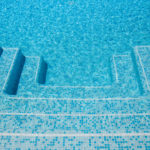 Chlorine keeps your pool safe and sanitary in the same efficient manner that makes it the number one water purifier in the world. It is a sanitizer and oxidizer, proving very effective at keeping your pool free from the buildup of undesirable bacteria infestations and algae blooms. Additionally, chlorine as a very potent oxidizer can actually improve water clarity and extend filter cycles as it readily destroys impurities and bacteria that would otherwise cloud the water and clog filters. You can see that there are tangible benefits and cost savings over the long term for the pool that is professionally treated with proper water chemistry.
Chlorine keeps your pool safe and sanitary in the same efficient manner that makes it the number one water purifier in the world. It is a sanitizer and oxidizer, proving very effective at keeping your pool free from the buildup of undesirable bacteria infestations and algae blooms. Additionally, chlorine as a very potent oxidizer can actually improve water clarity and extend filter cycles as it readily destroys impurities and bacteria that would otherwise cloud the water and clog filters. You can see that there are tangible benefits and cost savings over the long term for the pool that is professionally treated with proper water chemistry.The proven performance of this sophisticated chemistry does work for you.
Eye Irritation – It’s NOT the chlorine!
The ONLY way to destroy these chlorimines from your pool is by higher levels of available or “free” chlorine. Thus, HIGHER levels are necessary to continue the process of disinfection.
Effective Chlorination
Effective chlorination requires the addition of enough chlorine to do the immediate job of sanitizing and oxidizing, and then to provide enough residual to satisfy future demand. Of course, no water treatment is complete without adequate filtration, circulation, and maintenance. – Information provided by the Swimming Pool Water Treatment Professionals.
“Whether it be a public or residential vessel, bathers will not be harmed even when free chlorine levels are maintained at 10 to 15 ppm.”
– Pool and Spa News 1994.
We look forward to hearing from you Contact Us










